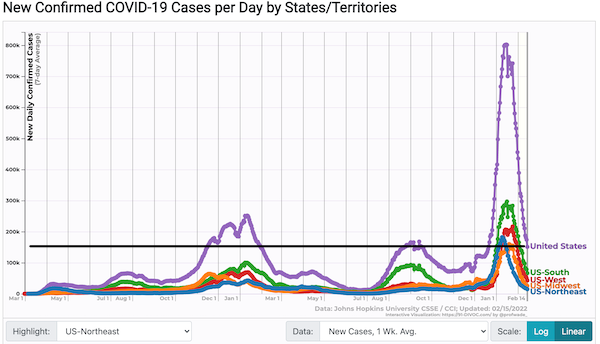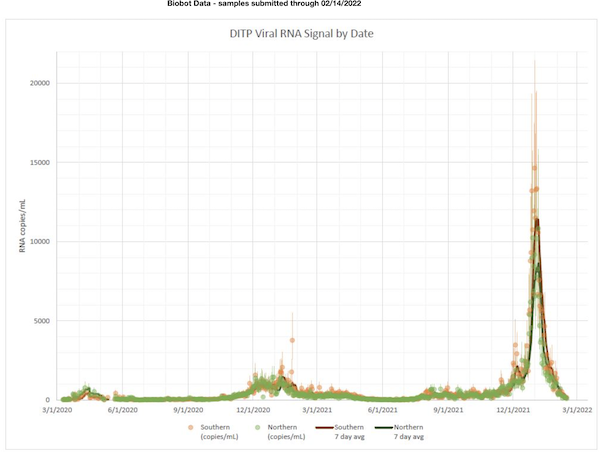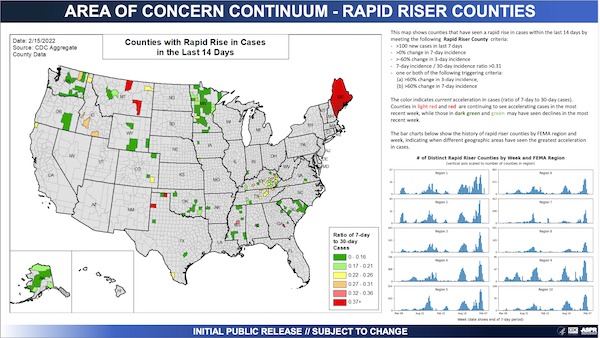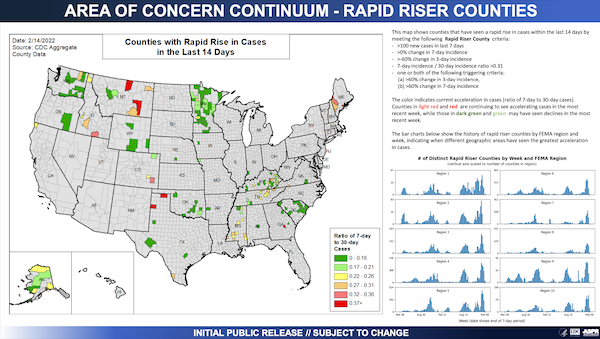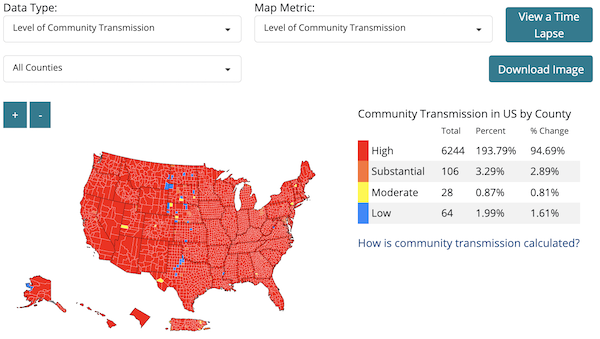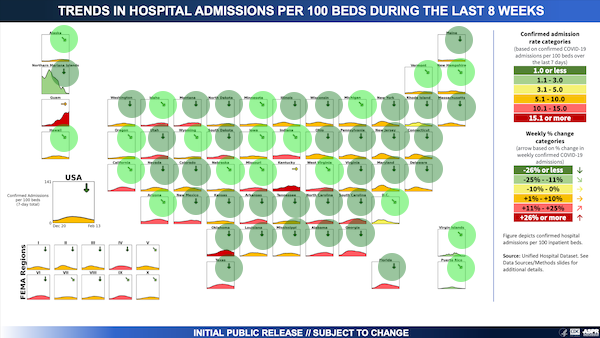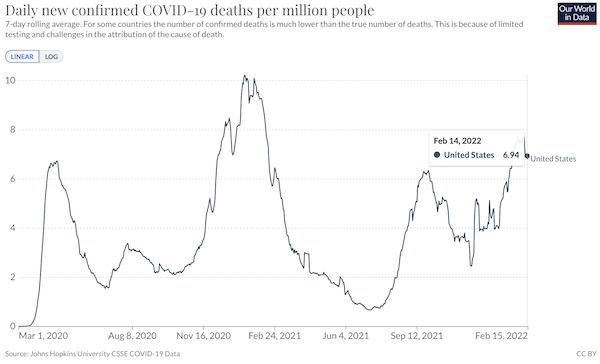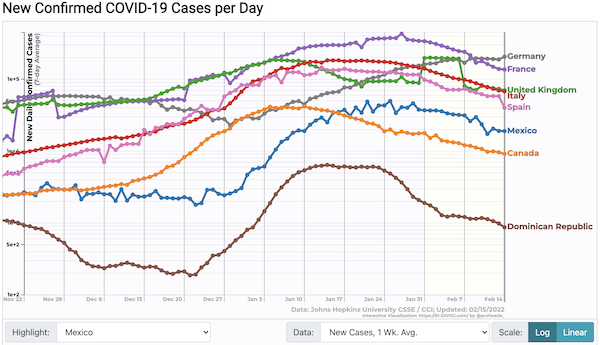[ad_1]
By Lambert Strether of Corrente
Bird Song of the Day
Politics
“But what is government itself, but the greatest of all reflections on human nature?” –James Madison, Federalist 51
“They had learned nothing, and forgotten nothing.” –Charles Maurice de Talleyrand-Périgord
“When the going gets weird, the weird turn pro.” –Hunter Thompson
Biden Adminstration
“Biden says he put a dead dog on a Republican woman’s doorstep while serving as a Delaware county official and promises to ‘work like the devil’ to bring down gas prices in National Association of Counties speech” [Dailly Mail]. “He recalled how he represented a middle class to working class district, with ‘one very wealthy neighborhood’ within its confines. ‘And I got a call one night, a woman said to me – obviously not of the same persuasion as I was politically – call me and say, ‘there’s a dead dog on my lawn,” the president said. ‘And I said, “yes ma’am, did you call the county?’ And she said, ‘yes, they’re not here.’ And I said, ‘well, I’ll get ’em in the morning,” he recalled. The woman wouldn’t accept that answer. ‘She said, “I want it removed now, I pay your salary,” the president said. ‘So I went over. I picked it up. She said I want it out of my front yard,’ Biden said. ‘I put it on her doorstep,’ he added, to laughs.” • A long time ago, I made the argument that one clear dividing line between Republicans and Democrats was the Republicans abused animals (including dead ones), and Democrats didn’t. (There’s quite a list at the post.) I guess I was wrong; it’s bipartisan.
“Democrats to Biden: Time to make changes at the White House” [NBC]. “A White House official defended Biden’s record on Capitol Hill when asked about some Democrats’ frustration with Klain. ‘The reality is there is a 50-50 Senate and four-vote margin in the House for Democrats,’ the official said. ‘Getting anything passed is incredibly difficult. The fact that we got the American Rescue Plan passed, as well as the Bipartisan Infrastructure Law passed, is remarkable and speaks to the skill of the team we have led by the president, and BBB is a work in progress that we are confident we can still get done.” Zeints walking into Klain’s office with a measuring tape for the rugs. More: “Philippe Reines, a onetime top adviser to Hillary Clinton, said a staff shake-up wouldn’t be a magic bullet. ‘He’s not one staffer away from a higher approval rating,’ Reines said.” So why do it? More: “Reines attributed the high disapproval numbers to an electorate so polarized that half would never support Biden. The numbers, he said, also reflect discontent over an unrealistic expectation that the sheer act of ousting former President Donald Trump and electing Biden would shut off the noise and bring a semblance of civility back to politics.” • That was their pitch, ffs! Well, that and “ending” Covid, and certainly not having a massive Delta spike followed by an even more massive Omicron spike.
“Okay We Did What The Smartest Boys On The Internet Told Us To” [Eschaton]. “All the Dem governors are doing a high profile coordinated “RELAXING ALL COVID MEASURES,” because they are convinced this is what The People want. I’m not so concerned about the specific measures, but the brain worms that have led to the belief that it isn’t the ongoing stress of the reality of covid that is bothering people, but the meager measures to reduce spread. Since the restrictions barely exist anywhere, these big announcements are going to be followed by ‘um, nothing’s much changed?’”
“Americans’ Trust in Scientists, Other Groups Declines” [Pew Research Center]. “Americans’ confidence in groups and institutions has turned downward compared with just a year ago. Trust in scientists and medical scientists, once seemingly buoyed by their central role in addressing the coronavirus outbreak, is now below pre-pandemic levels. Chart shows public confidence in scientists and medical scientists has declined over the last year
Overall, 29% of U.S. adults say they have a great deal of confidence in medical scientists to act in the best interests of the public, down from 40% who said this in November 2020. Similarly, the share with a great deal of confidence in scientists to act in the public’s best interests is down by 10 percentage points (from 39% to 29%), according to a new Pew Research Center survey.” • I could also file this under 2022, 2024, Democrats en Déshabillé, or Realignment and Legitimacy, given that is a massive loss of trust in the Democrat base.
Democrats en Déshabillé
I have moved my standing remarks on the Democrat Party (“the Democrat Party is a rotting corpse that can’t bury itself”) to a separate, back-dated post, to which I will periodically add material, summarizing the addition here in a “live” Water Cooler. (Hopefully, some Bourdieu.) It turns out that defining the Democrat Party is, in fact, a hard problem. I do think the paragraph that follows is on point all the way back to 2016, if not before:
The Democrat Party is the political expression of the class power of PMC, their base (lucidly explained by Thomas Frank in Listen, Liberal!). ; if the Democrat Party did not exist, the PMC would have to invent it. . (“PMC” modulo “class expatriates,” of course.) Second, all the working parts of the Party reinforce each other. Leave aside characterizing the relationships between elements of the Party (ka-ching, but not entirely) those elements comprise a network — a Flex Net? An iron octagon? — of funders, vendors, apparatchiks, electeds, NGOs, and miscellaneous mercenaries, with assets in the press and the intelligence community.
Note, of course, that the class power of the PMC both expresses and is limited by other classes; oligarchs and American gentry (see ‘industrial model’ of Ferguson, Jorgensen, and Jie) and the working class spring to mind. Suck up, kick down.
* * * I have said that I regret not having begun reading Bourdieu with Classification Struggles; I foolishly expected Forms of Capital to be something like The Bearded One’s Capital, and it isn’t. That said, Forms of Capital really is a scalpel to tease apart the rotting, impacted tissues of today’s discourse and its producers, so perhaps it is most useful in the present moment. Bourdieu has said that his worked example — a “top ten” ranking of French philosophers, with a list of experts who compiled the ranking at the end — is a “scale model” showing how his “method” (which I cannot yet summarize) can be applied to many fields. Let’s look at three examples, and see if Bourdieu can throw them into one bucket:
“Which one represents the real China?”
How do you say “false dichotomy” in Chinese https://t.co/RQO7EAEJLM pic.twitter.com/06i5hwUnUk
— Typos of the New York Times (@nyttypos) February 16, 2022
“Taking seriously as an intellectual movement”:
I am sorry to see the @nytimes taking MMT seriously as an intellectual movement. It is the equivalent of publicizing fad diets, quack cancer cures or creationist theories. https://t.co/q1JhAg9CCz
— Lawrence H. Summers (@LHSummers) February 6, 2022
Games we might call “The Defense Department,” “Meritocracy,” and “Greed,” respectively:
Here are five ways @wirecutter found to make cold February days stuck inside a little more fun. https://t.co/neMHluAmd5 pic.twitter.com/KZI73xqTgo
— The New York Times (@nytimes) February 13, 2022
Now, Bourdieu, from Forms of Capital, pp 46-47 (I am actually farther along than this):
[B]ehind the apparent object of the ranking [“top ten” –lambert] list, the real object is the establishment as judges of those people who are listed.
That is, the point of the Bordieu’s “top ten” list is not the philosophers at all, but who gets to be one of the experts picking them.
What I want to do is comment on the body of judges [I said “experts”–lambert] constituted. A constituent body is a body assembled aned named by an act of nomination; for example, the Conseil d’Etat [State Council]….. This constituent body is disguised by the product of its actions; . In other words, there is an operation of by the list drafters, and this, it seems to me, is the real issue… If we accept what they are doing, it is because there are ranking list drafters in other areas too (for example, they tell you: “These are the top ten films”)
Or, in political journalism, the leading candidates.
.
Rather like little Napoleons crowning themselves:
For the avoidance of doubt, the above is not a portrait of Larry Summers. In any case, the examples above look at awful lot like Bordieu’s “scale model.” “[T]he real object is the establishment as judges of those people [or topics, or whatever] who are listed.”
* * * “Left-Wing Staffers Bias Democrats Leftward. Hill Staff Unions Would Make This Worse” [Josh Barro, Very Serious]. “When Democratic politicians are swayed by the unrepresentative interests and values of staff, that isn’t simply a cognitive error. It’s a principal-agent problem: Political staffers have preferences, and as humans, they are inclined to use the influence they have to get elected officials to act in accordance with those preferences. Like activists or corporations or donors or voters, staffers are stakeholders with interests, and they will inevitably look for ways to use their power to get the party to serve those interests. So if you want to address the issue Matt describes, you will have to make the staff less influential over the political direction of the party. You need less worker power. And that is a very awkward thing to say in Democratic politics right now.” • Barro doesn’t define “left,” and by “left” I would bet he means identity politics a.k.a the successor ideology. Since the 2020 Sanders staff arguably diverted Sanders from his simple 2016 economic message, perhaps Barro should simply collect his winnings and sit down.
“The Losing Democrats Who Gobbled Up Money” [The New Republic]. Remember Amy McGrath? ” By Election Day, McGrath had brought in a record-obliterating $94 million—$63 million more than had ever been raised for a campaign in Kentucky. McConnell dramatically stepped up his fundraising this time around, but she still outpaced him by $27 million… Modern political campaigns like McGrath’s are multimillion-dollar pop-ups. The operatives involved in them raise the money, spend it, shut it all down after Election Day, and move on. They are not accountable to a board of directors or to the donors who fund the campaigns. A big chunk of the cash raised from donors comes back to the campaign pros in the form of fees and commissions for creating TV and digital advertising—for placing those ads, which is known as media buying—and for the fundraising itself. McGrath’s campaign manager, Mark Nickolas, had stepped away from politics for six years before getting back into the game to work with her. He viewed himself as an outsider and was critical of the campaign ecosystem. ‘An incestuous f*cking orgy of money,’ is how he referred to it in one of our conversations…. McConnell routed her in the only metric that ever matters. When the ballots were counted, he had 417,000 more votes—58 percent of the electorate to her 38 percent…. The same pattern held in other states where Democrats challenged long-entrenched incumbents whom progressives regarded as archvillains. Donors gave and gave to the challengers, largely via ActBlue, an online fundraising platform that makes political giving as easy as one-click purchasing on Amazon…. In Maine, Sara Gideon, a Democrat running against Susan Collins, raised so much—$74.5 million—that there were not enough ways to spend it.” • There’s a lot of stupid money in PMC land, apparently. And then this: “Democratic candidates also raised money in highly deceptive ways. “FINAL CABLE PAYMENT DUE,” read the top of an email sent on the day before the November election from the Harrison campaign. “We just got a surprise bill from the cable company. So we need to raise $384,599 to keep our TV ads running until the polls close.” What, he was in danger of having his HBO cut off?” • Put down your coffee, grab a bucket and keep it near, and read the whole thing.
“How much members of Congress are spending on personal security” [Axios]. Handy chart:
2022
* * *
Realignment and Legitimacy
“S.F. school board recall: Alison Collins, Gabriela López and Faauuga Moliga ousted” [San Francisco Chronicle]. “San Francisco voters overwhelmingly supported the ouster of three school board members Tuesday in the city’s first recall election in nearly 40 years…. The recall divided the city for the past year, with a grassroots effort of frustrated parents and community members pushing for the trustees’ removal over the slow reopening of schools during the pandemic and the board’s focus on controversial issues like renaming 44 school sites and ending the merit-based admission system at Lowell High School…. The recall drew support from a wide range of city officials, including Breed, state Sen. Scott Wiener, state Treasurer Fiona Ma, as well as current and former supervisors and school board members…. As of Monday, the pro-recall organizers had pulled in nearly $2 million, a jaw-dropping amount for a school board election. The opposition had raised $86,000, including $47,000 specifically donated to keep Moliga in office. Opponents of the recall, including the teachers’ union, described the effort as an attempt by billionaires to take over the school board, an attack on three people of color as well as a waste of money, given the upcoming election.” • Given Taibbi’s reporting on Loudoun County, I’d expect to see Asian voters coming out in support of the “merit-based admission system, but that doesn’t appear in this story. And while the recall supporters are presented as rebels, they also had the support of electeds and billionaires (who obviously one should trust with the public interest as far as you can throw a concert grand piano). Maybe Taibbi should take a trip to San Francisco….
“San Francisco recalls school board members seen as too focused on racial justice” [WaPo]. WaPo reports what the local paper doesn’t: “The board also argued that Lowell High School, an elite program populated overwhelmingly by Asian American and White students, needed an admissions system that would better represent the city’s Black and Hispanic residents. The board’s abrupt decision to alter the admission rules, switching to a lottery, incensed San Francisco’s large Chinese American population.” • If the Republicans are able to nationalize — I can’t think of a clever catchphrase, that’s a job for a strategist — “our failing schools,” that could make 2024 very interesting (not least if they peel off another identity vertical whose demographic growth was supposed to bring inevitable victory to Democrats).
Here is T.K. of Ask a Korean on American schools:
I can’t see how that doesn’t completely warp your sense of interpersonal trust. I don’t need any reason to take a walk through my old HS in Korea, I can do it for the sake of nostalgia. In the US, I would have to make an appointment and they would suspect my motives.
— T.K. of AAK! (@AskAKorean) February 16, 2022
Seems like “a constant state of dread and terror” is the point?
“Kids Have No Place in a Liberal Democracy” [Elizabeth Bruenig, The Atlantic]. “We are building toward a series of portentous midterm elections that might as well be called the Kinderreferenda, with exactly none of the whimsy or charm that word entails. Whether the specific issues relating to children that parents, politicians, pundits, pediatricians, and peanut gallerists have spent the past several months debating—school closures, vaccine mandates, masking, appropriate reading material, classroom instruction and the role of families therein—appear on every or any ballot is irrelevant; the fate of the nation’s children is the engine of moral concern driving electoral activity local and national, left and right. If Glenn Youngkin’s surprise gubernatorial win in Virginia last year was secretly foretold in every fractious school-board meeting and town hall preceding it, then it was also a portent of things to come: It’s a childish world, and we’re all just living in it. This is in every way typical. America revisits certain arguments about children over and over again, litigating the same matters ever more viciously, sometimes in different forms, always with ulterior motives…. Our world is structured around the core notion that people are free and equal, and that ideally they ought to be left alone by state and neighbor to manage their own affairs, so long as their activities don’t impose upon others…. In that sense, children are a paradox for liberalism. On the one hand, it’s crucial that they obey adults in their daily life, because they rely on adult competence and judgment to stand in while they develop their own. On the other, the helplessness of children, coupled with the fact that they too are wholly human persons, obligates others to them—meaning, in short, that children both take orders and give them by nature of their very existence. Children are bundles of obligations, theirs and ours to them, and their vulnerability and needs leave little room for the sort of political freedom the imaginary liberal subject is presumed to have. What to do with such unusual people?”
#COVID19
Case count by United States regions:
I have again added a “Fauci Line” to congratulate Biden and his team — Klain, Zeints, Fauci, Walensky — for finally falling below their own second-highest peak. (Rise like a rocket, and fall like a stick; the slope of the downward curve is more or less the same as the upward curve. Previous peaks — how small the early ones look now — have been roughly symmetrical on either side. But the scale of this peak, and the penetration into the population, is unprecedented.) I wonder if there will be plateau when BA.2 takes hold. Since the Northeast has form, that is probably the region to watch for this behavior first.
The official narrative was “Covid is behind us,” and that the pandemic will be “over by January” (Gottlieb), and “I know some people seem to not want to give up on the wonderful pandemic, but you know what? It’s over” (Bill Maher) was completely exploded. What a surprise! This time, it may be different. But who knows?
MWRA (Boston-area) wastewater detection:
Continues encouraging. No jump from the return of the students yet, which is even more encouraging, especially if you’re in “Waiting for BA.2” mode.
The Massachusetts Water Resources Authority (MWRA) service area includes 43 municipalities in and around Boston, including not only multiple school systems but several large universities. Since Boston is so very education-heavy, then, I think it could be a good leading indicator for Covid spread in schools generally.
From CDC Community Profile Reports (PDFs), “Rapid Riser” counties:
Continued improvement. Maine is a data problem. (Remember that these are rapid riser counties. A county that moves from red to green is not covid-free; the case count just isnt, well, rising rapidly.)
The previous release:
Here is CDC’s interactive map by county set to community transmission:
Hospitalization (CDC Community Profile):
Sea of green! From the point of view of our hospital-centric health care system, green everywhere means the emergency is over (and to be fair, this is reinforced by case count and wastewater). However, community transmission is still pervasive, which means that long Covid, plus continuing vascular damage, are not over. (Note trend, whether up or down, is marked by the arrow, at top. Admissions are presented in the graph, at the bottom. So it’s possible to have an upward trend, but from a very low baseline.)
Death rate (Our World in Data):
Total: 949,269 946,224. A dip, fortunately. I sure hope we break a million before Biden’s State of the Union speech. There’s still time.
Covid cases in top us travel destinations (Statista):
Good news here too.
Stats Watch
Retail Sales: “U.S. Retail Sales” [Trading Economics]. “Retail sales in the US jumped 3.8% mom in January of 2022, rebounding from an upwardly revised 2.5% drop in December, and much better than market forecasts of a 2% rise. It is the biggest increase in retail sales in ten months, as consumers continued to spend in spite of the surge in COVID-19 cases and hot inflation. Biggest gains were seen in nonstore retailers (14.5%); furniture stores (7.2%); auto dealers (5.9%); building materials and garden equipment (4.1%); general merchandise stores (3.6%); electronics stores (1.9%); food and beverages (1.1%); and clothing stores (0.7%). On the other hand, sales declined at gasoline stations (-1.3%); sporting goods, hobby, musical instruments and book stores (-3%); and restaurants and bars (-0.9%).”
Manufacturing: “United States Industrial Production” [Trading Economics]. “Industrial Production in the United States increased 4.10 percent year-on-year in January of 2022, following an upwardly revised 3.8 percent rise in December.”
Manufacturing: “United States Manufacturing Production MoM” [Trading Economics]. “Manufacturing production in the United States went up 0.2 percent from a month earlier in January of 2022, after a 0.1 percent fall in December and compared to market expectations of a 0.3 percent increase. Durable manufacturing, nondurable manufacturing, and other manufacturing (publishing and logging) each recorded increases of 0.2 percent. Within durables, miscellaneous manufacturing and machinery posted the largest gains, while motor vehicles and parts and nonmetallic mineral products posted the largest losses.”
Inventories: “United States Business Inventories” [Trading Economics]. “Manufacturers’ and trade inventories in the US rose 2.1 percent from a month earlier in December of 2021, after an upwardly revised 1.5 percent increase in the prior month and in line with market expectations.”
Inflation: “Inflation Will Be Exactly What People Expect It to Be” [Tyler Cowen, Bloomberg]. “Sometimes yesterday’s crazy idea turns out to be sane or even essential. For instance, Fischer Black, the late finance economist and co-discoverer of modern options pricing theory, argued that the rate of price inflation will be whatever we think it will be. If expectations are that inflation will be high, it will be high. If expectations are that inflation will be low, it will be low. For Black, who died in 1995, this was always true, at least for modern economies. I never agreed with Black on this point, but increasingly I have begun to wonder if he wasn’t on to something…. In Black’s view of the world, if people expected inflation to be high, they would spend and borrow more. Banks would create the money for this process to be self-sustaining. Under this framework, Black might have argued that no major inflation resulted after 2008 because Americans simply were not bullish enough, given the recent financial trauma.” • Or what people expect their friends to think it will be. Or what people expect their friends to think what Central Bankers think it will be.
Tech: “Which Vehicles Will Lose Safety Features After 3G Shutdown This Month?” [Newsweek (dk)]. “s part of the ongoing rollout of 5G wireless technology in the U.S., cellular carriers will begin phasing out 3G services later this month to make room for the faster network. As a result, a number of vehicles will begin losing safety features designed around 3G technology. Some vehicles will lose access to these features by the end of February, while others will lose them over the course of 2022.” • Cars are named, but this doesn’t seem to be an exhaustive list.
The Bezzle: “Elon Musk’s Neuralink destroyed monkeys’ brains before killing them” [Al Mayadeen]. “The US Department of Agriculture (USDA) and the Physicians Committee for Responsible Medicine (PCRM) filed a complaint against the research, saying it caused “extreme suffering” on the monkeys, as they ‘had their brains mutilated in shoddy experiments and were left to suffer and die.’ The complaint addresses both Neuralink and the University of California who partnered in this experiment between 2017 and 2020. In the experiment, researchers implanted small devices into the skulls of macaque monkeys. The PCRM, through obtaining health records and necropsy reports, said the documents reveal that the monkeys have been suffering “extreme psychological distress” as a result of the crude surgeries. Neuralink used something called ‘BioGlue’ which destroyed regions of the monkeys’ brains, causing devastating psychological effects, including anxiety, vomiting, poor appetite, hair loss and self-mutilating behavior. Some even removed their own fingers. In response, Neuralink called the complaint ‘misleading’, saying in a blog post that the company ‘did and continues to meet federally mandated standards.’ Addressing the deaths of the monkeys, Neuralink attributed the deaths to ‘terminal procedures’ where the monkeys were euthanized after surgery.” • Oh.
The Bezzle: “Money That Won Melania Trump NFT Came From Melania Trump Wallet” [Bloomberg]. “The source of funds for the winning bid in Melania Trump’s first NFT auction appears to be the creators of the project themselves. A series of blockchain transactions show that the cryptocurrency used to purchase Trump’s nonfungible token came from a wallet that belongs to the entity that originally listed the project for sale. The former first lady began an auction in January for a collection of NFTs on the Solana blockchain, with art from her first official state visit in 2018.” • Remarkable, when the whole point of cryto is to enable anonymouys transactions. The Republicans simply will not learn the value of layer of indirection! Very much unlike Democrats, I might add.
The Bezzle: “Why you can’t rebuild Wikipedia with crypto” (interview) [Molly White, Platformer]. Q: “Is there one story in crypto history that you regard as the quintessential ‘web3 is going great’ story?” WHITE: “I think I’d have to pick the Bitfinex hack. It’s got a little bit of everything! Multiple hacks, including of course the infamous August 2016 hack of almost 120,000 bitcoin (worth $72 million at the time, worth several billion today). There’s been tons of shady business by executives, some involving Tether, and some of which has led to huge fines in the past year. And of course it’s got the “reality is truly stranger than fiction” aspect that makes for some of the best W3IGG entries: the recent discovery of some of those stolen bitcoins as they were allegedly being laundered by a New York couple, one of whom moonlighted as an extremely weird rapper.”
Transportation: “BIF: The Growth of US Railroads” (podcast) [Congressional Dish]. “The infrastructure law provides the most significant investment in passenger rail in U.S. history, but substantial hurdles – including a powerful cartel – stand firmly in the way of a real national network. In this episode, learn the ways the infrastructure law paves the way for a better future for passenger rail along with the significant obstacles that it failed to address.”
Today’s Fear & Greed Index: 38 Fear (previous close: 38 Fear) [CNN]. One week ago: 40 (Fear). (0 is Extreme Fear; 100 is Extreme Greed). Last updated Feb 16 at 1:24pm. Back to flirting with Neutral!
Dear Old Blighty
Prince Andrew skates:
The grand old Duke of York, he had 12 million quid. He gave it to someone he never met, for something he never did.
— Rod ? #JohnsonOut #DontLookUp?? #FBPE ? (@splodders) February 16, 2022
Our Famously Free Press
For Want of a Cup: The Rise of Tea in England and the Impact of Water Quality on Mortality (PDF) The Review of Economics and Statistics. From the Abstract: “This paper explores the impact of water quality on mortality by exploiting a natural experiment—the rise of tea consumption in 18th century England. This resulted in an unintentional increase in consumption of boiled water, thereby reducing mortality rates.” • Interesting! However, I’m filing it here because of Noah Smith’s comment:
Maybe we can slip Covid vaccines into the antivaxxers’ fentanyl https://t.co/A8JbTkKsCo
— Noah Smith ?+?=? (@Noahpinion) February 14, 2022
Ha ha! Pretty funny!
Class Warfare
Indeed:
If I had such a stellar resume, I expect I’d think about it in descending order along these lines:
– Survived poverty
– Unionized Starbucks
– Won scholarship— Corey Pein ????? (@coreypein) February 13, 2022
News of the Wired
“Why Are Letters Shaped the Way They Are?” [Wired]. “[Max Planck Institute] researchers found that some symbols did evoke certain colors more than others, and the associations between symbols and colors were stronger in people who played regularly [on the Color Game app]. The Color Game did more than show how languages form over time, it violated a long-standing rule in linguistics: the rule of arbitrariness. In the subject of semiotics, or the use of signs and symbols to convey meaning, most students are taught about the theories of linguist Ferdinand de Saussure. He wrote that the letters and words in many writing and language systems have no relationship to what they refer to. The word ‘cat’ doesn’t have anything particularly cat-like about it. The reason that ‘cat’ means cat is because English speakers have decided so—it’s a social convention, not anything ingrained in the letters c-a-t. … But the idea that words, or other signs, do actually relate to what they’re describing has been gaining ground. This is called iconicity: when a spoken or written word, or a gestured sign, is iconic in some way to what it’s referring to. …. ‘It is now generally accepted that natural languages feature plenty of non-arbitrary ways to link form and meaning, and that some forms of iconicity are pretty pervasive,’ said Mark Dingemanse, a linguist at Radboud University, who said that he too learned in Linguistics 101 that ‘the sign is arbitrary.’ ‘Iconicity has become impossible to ignore.’… Voiceless consonants, or consonants that you don’t use vocal cords to produce like p-, t-, k-, and ch- are often associated with small sizes, and voiced consonants are associated with big ones; the unvoiced consonant k in korokoro is used to refer to a stone’s lightness and g- represents the rock’s heaviness. ‘Originally these were considered on the margins of language,’ Perlman said. ‘But now we’ve come to realize that these idiophones are in all languages. And they’re much more common than we realize.’ One of the most documented examples of iconicity is the bouba/kiki effect, similar to the takete–maluma effect. People associate bouba with round objects, and kiki with pointy ones. Most recently, in November 2021, this was demonstrated in speakers of 25 languages and 10 writing systems.” • Remarkable!
“Turning off my phone improved my science” [Nature]. “As I began to search for the cause of my struggles, I became increasingly aware that my ‘quiet time’ at the lab bench — for instance, when I was running chromatography columns or microscopy experiments — was anything but. Instead of thinking about science, I was watching television or interacting with social media on my smartphone. Although I could mask this inefficiency with longer hours, my work felt chaotic and disorganized. I was working more than ever, but getting less done. I would come home from a long day in the lab and respond to e-mails or Slack messages over dinner or in bed. This all came to a head last summer, when my inability to balance work and life led me to seek help from the university’s student mental-health services. Through a combination of counselling and personal reflection, I came to understand my problem: I was addicted to my phone.”
“The Legend of the Wartime Placebo” [McGill Office for Science and Society]. “There is a foundational myth in placebo research that has been repeated over and over again, sometimes with inexplicable flourishes, often with the variations one expects from a telephone game. You have probably read it in a mainstream publication. It’s the story of a doctor, working in dark times, who cannot do his job properly and accidentally discovers the power of the placebo to relieve pain. It is such a good story. And it might not even be true. What follows is a story of my own. This one is true, and it involves bad scholarship, the basement of a library, and an episode of the television show M*A*S*H. This is my story of the story of Dr. Henry Beecher who ran out of morphine while treating soldiers, and how it may never have happened.”
Contact information for plants: Readers, feel free to contact me at lambert [UNDERSCORE] strether [DOT] corrente [AT] yahoo [DOT] com, to (a) find out how to send me a check if you are allergic to PayPal and (b) to find out how to send me images of plants. Vegetables are fine! Fungi and coral are deemed to be honorary plants! If you want your handle to appear as a credit, please place it at the start of your mail in parentheses: (thus). Otherwise, I will anonymize by using your initials. See the previous Water Cooler (with plant) here. Today’s plant:
Readers: Water Cooler is a standalone entity not covered by the recently concluded and — thank you! — successful annual NC fundraiser. So if you see a link you especially like, or an item you wouldn’t see anywhere else, please do not hesitate to express your appreciation in tangible form. Remember, a tip jar is for tipping! Regular positive feedback both makes me feel good and lets me know I’m on the right track with coverage. When I get no donations for five or ten days I get worried. More tangibly, a constant trickle of donations helps me with expenses, and I factor in that trickle when setting fundraising goals:
Here is the screen that will appear, which I have helpfully annotated.
If you hate PayPal, you can email me at lambert [UNDERSCORE] strether [DOT] corrente [AT] yahoo [DOT] com, and I will give you directions on how to send a check. Thank you!
[ad_2]
Source link


